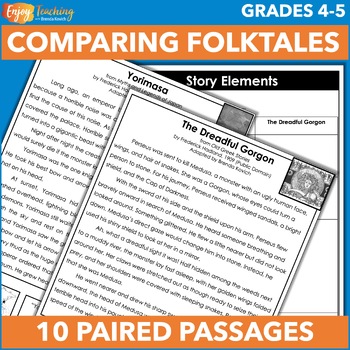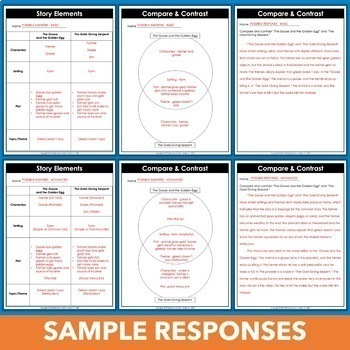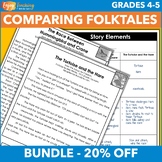Compare & Contrast 2 Stories - 10 Paired Passages - 4th & 5th Grade Folktales
- PDF
- Easel Activity
What educators are saying
Also included in
- Explore similar themes and topics in folktales from around the world. Three instructional slideshows, posters, fourteen paired passages, and graphic organizers provide a complete, differentiated ELA unit. Fourth and fifth grade students learn to identify characters, setting, plot, and theme; find siPrice $16.80Original Price $21.00Save $4.20
Description
Compare and contrast literature with ten paired passages. This set emphasizes identification and use of story elements to construct responses. Students read two folktales, organize elements in tables, transfer them to Venn diagrams, and explain in paragraphs.
Open the preview to take a closer look.
Five sets of folktales from around the world were carefully selected and adapted for fourth and fifth grade students.
- “Mani and Sol” (Norway) and “The Fire Dog” (Korea)
- “The Goose and the Golden Egg” (Samoa) and “The Gold-Giving Serpent” (India)
- “The Talking Eggs” (United States) and “Cinderella” (France)
- “Yorimasa” (Japan) and “The Dreadful Gorgon” (Greece)
- “Hummingbird and Crane” (United States) and “The Tortoise and the Hare” (Samoa)
Additional resources support students as they analyze the tales.
- Lists of common characters, settings, plots, and themes (archetypes)
- Tables to list elements
- Venn diagrams to compare
- Sample responses – basic and advanced
Students use a clear, straightforward process.
- Identify the elements (characters, setting, plot, and theme) of each passage and record them in a two-column table.
- Use a Venn diagram to categorize similarities and differences in the stories’ elements.
- Construct responses to communicate how the two pieces of literature are alike and different.
You can differentiate to meet the needs of all students in your class or homeschool.
- Remedial - Read and discuss paired folklore together. Ask students to identify characters, setting, and plot then write a one-paragraph response.
- Basic - Ask students to read stories independently; identify characters, setting, plot, and theme; and write a one-paragraph response.
- Advanced - Ask students to read stories independently; identify characters, setting, plot, and theme; determine archetype for each; and write a longer response (one or more paragraphs).
You'll love these resources!
- High-interest literature can be used to compare and contrast - or for an activity of your choice. You'll use them year after year.
- Processes support fourth and fifth grade standards, such as CCSS 4.9 and 5.9; Texas TEKS LA.4.7.B, LA.4.9.A, LA.5.7.B, LA.5.9.A; and Virginia VA SOL.R.4.5.d, R.4.5.i, R.5.5.f, and R.5.5.l.
- Support materials encourage higher-order thinking skills and allow your students to complete complex tasks with ease.
Passages and response sheets are included as a printable PDF and interactive Easel Activities.
Enjoy teaching!
Brenda Kovich







